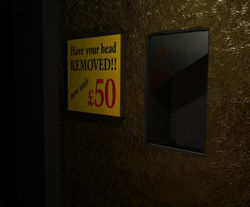Klestosapharot
The Klestosapharot is an unbelievably sinister ancient cult. It resembles that of Zoroaster, but is far more ancient[1] and really dangerous. It may well be the most terrifying and the most ancient cult that ever has existed, so evil that it takes superhuman courage to even write about it, or to publish the writings[2].
The first encounter[edit | edit source]
Evidence of Klestosapharot's existence was first found in 1699, when the French archetype André Toussaint came across a weird-looking ring in a curiosité shop on the banks of Seine. We can find this entry in his diary:
- "The ring obviously has a magical quality. It is apparently made of gold, with silver inlays. It also contains some metal I cannot recognise - some evil-looking metal. It is decorated with precious and semi-precious stones. In the dark it emits a slight radiance. It makes me uneasy - as if I were on the outskirts of a Great Mystery. It is also precious to me."
As might be expected, Toussaint lost his life a few months later in an accident that should not have happened: he was mountaineering in the french Alps and slipped, falling to a certain death. He took the ring with him, but luckily his diaries were left behind. Concerning the period between his finding the ring and his death, we have these mysterious entries in his diary:
- (1.3.1699) "I don't know how long I can take this suspense. I feel eyes on my back all the time, I cannot sleep at night, I cannot stay awake during daytime. All of my plans seem to go awry. I just hope I will not fall off those blasphemed Alps, they are always so sinister."
- (25.3.1699) "I am writing these pages in a forgotten hut in the Alps. The sherpas I acquired in the village of Krasnoyarsk two weeks ago seem reluctant to go any further. They are afraid of the Man of the Mountain, who will devour their souls if they go any further. There is something vaguely unsettling about this, but I'm determined to conquer Zetaplotocatl if it's the last thing I ever do. - - - I can make out some kind of writing on the inside of the ring. I accidentally threw it into the fireplace - when removing my alpinist gloves in a hurry - and when I took it out, it was simply burning my hand! I had never noticed metals heat up so quickly. There had been some dirt on the inside, and it got burned off. There are deep grooves, some very evil-looking text. It is probably some form of elvis. There is a name, starting with the letters W, A, N and K ... but I cannot make out any more of it. It is as if a mist of the Netherworld[3] is covering my eyes every time I try to read further. It is very terrifying."
Subsequent findings[edit | edit source]
August af Terburner and the Tombs of Mystery and Annihilation[edit | edit source]
- August af Terburner, the only son of the wealthy shipbuilder Roman af Terburner of Vienna, found and bought Toussaint's diaries in a curiosité shop on the banks of Seine shortly after the outset of the Napoleonic Wars. He immediately recognised their great value even though the language was foreign to him[4]. He took the diaries to someone who understood french and had them translated. Then he went home, opened the door of his study, went in, took off his coat and galoshes, pulled a chair for himself, sat down, took the translation from his battered leather suitcase, and finally started reading. From then on, things proceeded more quickly.
- Af Terburner, after reading and understanding many of the mysteries Toussaint hinted at in his diaries, bought a round-trip ticket to Near-to-Middling East. His purpose was to find the Tombs of Mystery and Annihilation or die trying[5]. Af Terburner arrived at his destination, Karagayly[6], on the morning of the 29th of April, 1878, after a series of adventures[7]. There he hired a caravan to take him to the lake Balkhash, on the shores of which he believed he would easily find hints of the whereabouts of the Tombs he was seeking.
- Two months later Af Terburner was still searching for clues with the help of some local trackers, hunters, and a full-fledged bastard. He felt totally lost, but then a visitor to his camp brought new hope. An entry in his diary:
- "This morning opened new, sunnier vistas for my adventurous journey! A mysterious, dark-skinned stranger arrived as if out of nothing and told me to go into that direction right there if I ever wanted to find the Tombs of Mystery and Annihilation. What idiotic luck! I was already giving up hope, seeing I'm not much good at this kind of thing!"
- This is the last coherent entry in af Terburner's diaries. He disappeared, and his body[8] was never recovered.
Jorgen Kossochov and the clay tablets[edit | edit source]
- By the end of the year 1890, a mysterious stranger arrived at the door of the World famous archaeologist Jorgen Kossochov in Bergen, Norway. The stranger didn't speak a word, but instead gave Kossochov a package and walked away. When Kossochov tried to follow and pose some questions, the stranger merely looked at him with a very evil eye and made an utterly secret sign that scared Kossochov out of his wits. Kossochov turned, ran back into his house and shuddered there for several minutes. It was quite a difficult time for him.
- In the package Kossochov found what was left of af Terburner's diaries, and a broken clay tablet. The tablet seemed to be immensely old. The language written on it was neither Greek, nor Arameic, Retoromanian, Latin, Urdu, Visigoth or Ancient Egyptian[9]. With the help of his colleagues and several linguists[10], Kossochov had the secret of the clay tablet solved in no time.
- Being brilliant did not save Kossochov from an "accident" the very same day he had the message of the tablet clear on paper. Part of the roof collapsed, and a candle set fire to the wood dust thus generated. Kossochov couldn't get out of the burning house. He managed to throw the paper - with the translation written on it - out of the window. Jeremy Lindqvist, esq. recovered it a few days later. He recollects in his memoirs:
- "The tablet seemed to be about 6000 years old, judging by the red dust that spattered it. It is very easy to notice and judge such things. What the tablet said was a riddle, though. We naturally didn't have anything to compare to - as the language was none we knew - so we just handled the text as if it had been any code. We subtracted anything repetitive, deciding it was the same word every time, and by that we suddenly had all the vocabulary clear. After that, we only had to translate the text to french, which Kossochov did not understand. We translated it to english for him. The translation reads:
- and the bigger man says to the smaller man these words: You shall do as I tell you or die. And the small man heeds not the words. And in the meantime -
- -and there was no more. It was just one tablet, you understand. We were frustrated, and decided to send one of our group back to lake Balkhash to try and find some more tablets or anything else that would shed some light to Klestosapharotians."
The Lindqvist expedition[edit | edit source]
- It was not hard to decide which of the scientists would go to lake Balkhash. The only one with any experience in archaeology was Lindqvist himself: the rest were just stooges. Lindqvist set out on January 23, 1952. It had taken the group sixty-two years to gather a budget. Lindqvist was 82 years old and suspected he would not live out the journey, Netherworld or not. Consequently he was in comparably good cheer when the train pulled off the Bergen station.
- Lindqvist had hardly arrived at Oslo when a mysterious stranger, dark-skinned, evil-looking, and immensely old, contacted him in his hotel. Out of Lindqvist's memoirs:
- "I shook his hand and asked him what he wanted. He told me had seeked me for years, and said his father had forgotten to take the rest of the clay tablets with him when he left for Norway from lake Balkhash. I looked at him in surprise. He confirmed my suspicion: he was the son of the very same mysterious stranger who had given the broken tablet to Kossochov! I agreed to meet him the following day at noon near Akerbrygge. He arrived on time, giving me ten more clay tablets and a map to guide me to the Tomb of Mystery and Annihilation. When I asked him what prompted him to do it, he just gave me the old evil eye, the mysterious sign, and a diabolical laugh. Then he vanished behind the corner. I'm too old to run after people with ten clay tablets in my arms, so I never found out what became of him."
- As is well known, nothing was left of Jeremy Lindqvist but his memoirs. He left for lake Balkhash, leaving the memoirs in the care of his son-in-law in Oslo, and - perhaps unwisely - took the clay tablets with him, to have something to read on the way to Kazakstan. The rest of the scientist group were dismayed and soon died of old age.
Renny Klimster and the solution to the riddle[edit | edit source]
Nothing certain was known of the cult of Klestosapharot until an absolutely brilliant young man called Ian "Renny" Klimster got hold of the photo of the clay tablet in 1983. It took him only five days to come up with a complete treatise on the belief system and common practices of the cult of Klestosapharot. It goes without saying that he died a miserable death right after publishing his paper. We give here only the main points[11].
Belief system[edit | edit source]
- In the cult of Klestosapharot, there are two or three Creators, uncreated beings themselves. One of them has created Heaven, and is called Klest[12]. He is the giver of the sacred and good things in life. Another is called Osapha, or, depending on sect, Osapharot: the cult appears to have been viciously split in two. The schism was caused by the number of gods[13].
The sect with two gods[edit | edit source]
- In this sect, there is only one other god besides Klest[14], Osapharot. He has created the rest of the Universe: the Earth, the Stars, the Sun and the Moon. He is also responsible if anything bad happens to you [15]. This sect is very much based on revenge[16].
The sect with three gods[edit | edit source]
- The main difference to the other sect is that there are - as already has been mentioned twice - three gods: Klest, Osapha, and Rot. Osapha corrensponds to the Osapharot of the other sect, and Rot is just evil - even more so than Osapha. He has a terrifying black hand, with which he squeezes, and his evil laughter is such that it stops the blood in your veins. His breath is cold and stinks of sulphur, and his look will turn everything into stone. He is six foot three[17], weighs two hundred kilograms, and wields a sword so sharp that even the sight of it will cut your arteries. He is as wily as a fox, and is always plotting terrible revenge against mankind because Surt, the first man, raped his eldest daughter. He can run at 120 miles per hour and jump over a train. Nobody who has ever seen him is alive. He is coming to get you so repent, you fools, repent!!
The cult today[edit | edit source]
In spite of all the horror and misery that the cult of Klestosapharot promises to all infidels, some magnate or other has managed to transform the Tombs of Mystery and Annihilation into a whopper of a tourist trap. Nobody knows who is behind the scheme, so this is yet another mystery to add to the already mysterious cult.
Beware![edit | edit source]
The entrance fee is astronomical!
The unnecessary stuff at the end of the article[edit | edit source]
- ↑ And therefore more important and mystical. See also Cthulhu and Cthulhu Day. Cthulhu is not related to Klestosapharot but is just about as sinister - maybe a bit less so.
- ↑ Let's hope we can avoid revenge.
- ↑ Not to be confused with the Netherlands. There is nothing sinister about them.
- ↑ Af Terburner spoke eighteen languages fluently. For some peculiar reason he had never learned french or german.
- ↑ In fact he was prepared to turn back if he as much as caught a flu, but he never let this on to anybody. As he stayed healthy until he reached the Tombs, nobody ever found this out before Jorgen Kossochov got his diaries - and the Old Steppe clay tablet - from a mysterious stranger.
- ↑ Now a part of Kazakstan.
- ↑ He recorded the adventures in his diaries, which can probably be acquired in some curiosity shop.
- ↑ Probably horribly mutilated by Underworld beings.
- ↑ For a complete list of the languages excluded from the tablets, see http://globalrecordings.net/languages
- ↑ Mr. Lindqvist, for instance.
- ↑ To avoid extermination. Note that I already nicked my finger.
- ↑ The Old Steppe clay tablet and secretly carved tomb texts in the hidden Tombs of Mystery and Annihilation have his name as Cloast or Blost.
- ↑ There is one further sect in the cult that claims four gods: Kle, Stos, Ap, and Harot. Nothing else is known about this sect. There remains an uncertainty of its existence.
- ↑ Or Cloast, Clast, Bloast, Closet or Post
- ↑ You can then burn a wooden statuette depicting him, spit over your left shoulder three times, do a backward somersault thrice, be silent for a week and scatter ashes over yourself. All standard procedures in any religion.
- ↑ Consequently the number of its members, originally only about 10 000, has dwindled to only a few through constant warring between families. The remaining members have already trouble finding each other - but the reasons of revenge still live on.
- ↑ Approximately 240cm.



